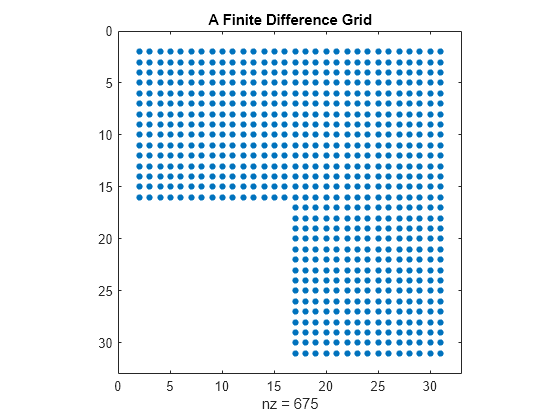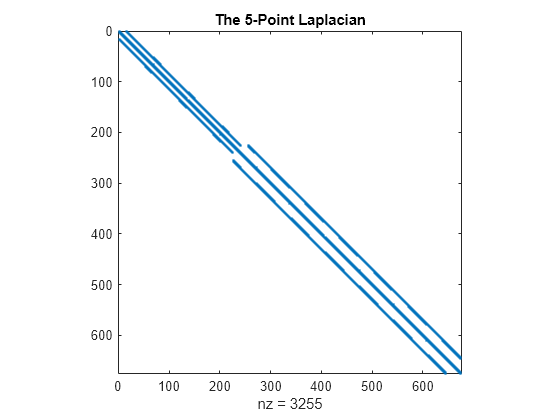有限差分拉普拉斯算子
此示例说明如何在 L 形域中计算和表示有限差分拉普拉斯算子。
域
numgrid 函数为 L 形域内的点编号。spy 函数可用于可视化矩阵中非零元素的模式。使用这两个函数生成并显示 L 形域。
n = 32; R = 'L'; G = numgrid(R,n); spy(G) title('A Finite Difference Grid')

取一个较小版本的矩阵作为样例。
g = numgrid(R,10)
g = 10×10
0 0 0 0 0 0 0 0 0 0
0 1 5 9 13 17 25 33 41 0
0 2 6 10 14 18 26 34 42 0
0 3 7 11 15 19 27 35 43 0
0 4 8 12 16 20 28 36 44 0
0 0 0 0 0 21 29 37 45 0
0 0 0 0 0 22 30 38 46 0
0 0 0 0 0 23 31 39 47 0
0 0 0 0 0 24 32 40 48 0
0 0 0 0 0 0 0 0 0 0
离散拉普拉斯算子
使用 delsq 生成离散拉普拉斯算子。同样使用 spy 函数显示矩阵元素的图形效果。
D = delsq(G);
spy(D)
title('The 5-Point Laplacian')
确定内部点的数量。
N = sum(G(:)>0)
N = 675
狄利克雷边界值问题
求解稀疏线性系统的狄利克雷边界值问题。问题设置:
delsq(u) = 1 在内部,u = 0 在边界上。
rhs = ones(N,1); if (R == 'N') % For nested dissection, turn off minimum degree ordering. spparms('autommd',0) u = D\rhs; spparms('autommd',1) else u = D\rhs; % This is used for R=='L' as in this example end
将解映射到 L 形网格并绘制等高线图。
U = G; U(G>0) = full(u(G(G>0))); clabel(contour(U)); prism axis square ij

现在,以网格图形式呈现该解。
mesh(U) axis([0 n 0 n 0 max(max(U))]) axis square ij
